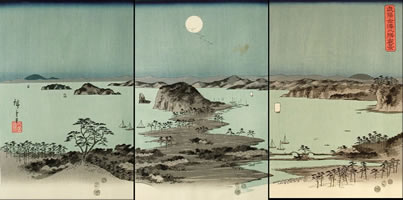![]() Guide: Music Inspired by Art
Guide: Music Inspired by Art
Setsugekka (Snow, Moon, and Flowers) is an 1857 series of three triptychs (artworks in three sections) by the Japanese master Ando Hiroshige (1797-1858). These woodblock prints, or Ukiyo-e (“pictures of the floating world”), convey Hiroshige’s vision of three different real-world landscapes representing the traditional thematic triad of snow (setsu), moon (getsu), or flowers (ka).
Hiroshige’s prints inspired me to compose Setsugekka, a work for violin and piano in three short movements (composed spring 2011). Each of the movements responds to the atmosphere and mood of the individual triptychs in the series: I. Mountain and River on the Kiso Road, II. Panorama of the Eight Views of Kanazawa under a Full Moon, and III. The Whirlpools of Naruto in Awa Province.
Play the audio below each image to hear a brief excerpt from that movement (and click the image to view a larger version):
Mountain and River on the Kiso Road
Panorama of the Eight Views of Kanazawa under a Full Moon
The Whirlpools of Naruto in Awa Province


